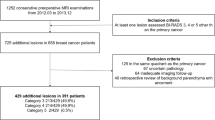Abstract
Objective
To retrospectively evaluate characteristics of and determine appropriate follow-up recommendations for BI-RADS category 3 lesions detected in preoperative MRI of breast cancer patients.
Methods
BI-RADS category 3 assessments were identified from the breast MRI database for 5,110 consecutive breast cancer patients who had undergone preoperative MRI and surgery. Patient and lesion characteristics, malignancy rate, and interval between lesion detection and cancer diagnosis were analysed. Histopathological results or imaging at or after 2-year follow-up were used as reference standards.
Results
Of the 626 lesions, morphological features included a single focus in 26.5% (n = 166), multiple foci in 47.1% (n = 295), mass in 21.7% (n = 136) and non-mass enhancement in 4.6% (n = 29). Cancer was found in 0.8% (5/626) at a median interval of 50 months (range, 29–66 months). Malignancy rate according to morphological feature was: 1.8% (3/166) in a single focus, 0.7% (1/136) in mass and 3.4% (1/29) in non-mass enhancement. All detected cancers were stage 0 or IA.
Conclusions
Annual follow-up might be adequate for BI-RADS category 3 lesions detected at preoperative MRI because of the 0.8% (5/626) malignancy rate, long interval between lesion detection and cancer diagnosis, and early stage of diagnosed cancers.
Key Points
• BI-RADS category 3 lesions on preoperative MRI had 0.8% malignancy rate.
• All cancer diagnoses from BI-RADS 3 occurred after 24-month follow-up.
• Annual follow-up might be adequate for BI-RADS 3 detected on preoperative MRI.



Similar content being viewed by others
References
Sickles EA (1991) Periodic mammographic follow-up of probably benign lesions: results in 3,184 consecutive cases. Radiology 179:463–468
Varas X, Leborgne F, Leborgne JH (1992) Nonpalpable, probably benign lesions: role of follow-up mammography. Radiology 184:409–414
Varas X, Leborgne JH, Leborgne F, Mezzera J, Jaumandreu S, Leborgne F (2002) Revisiting the mammographic follow-up of BI-RADS category 3 lesions. AJR Am J Roentgenol 179:691–695
Vizcaino I, Gadea L, Andreo L et al (2001) Short-term follow-up results in 795 nonpalpable probably benign lesions detected at screening mammography. Radiology 219:475–483
Chae EY, Cha JH, Shin HJ, Choi WJ, Kim HH (2016) Reassessment and follow-up results of BI-RADS category 3 lesions detected on screening breast ultrasound. AJR Am J Roentgenol 206:666–672
Chung CS, Giess CS, Gombos EC et al (2014) Patient compliance and diagnostic yield of 18-month unilateral follow-up in surveillance of probable benign mammographic lesions. AJR Am J Roentgenol 202:922–927
Lourenco AP, Chung MT, Mainiero MB (2014) Probably benign breast MRI lesions: frequency, lesion type, and rate of malignancy. J Magn Reson Imaging 39:789–794
Spick C, Szolar DH, Baltzer PA et al (2014) Rate of malignancy in MRI-detected probably benign (BI-RADS 3) lesions. AJR Am J Roentgenol 202:684–689
Grimm LJ, Anderson AL, Baker JA et al (2015) Frequency of malignancy and imaging characteristics of probably benign lesions seen at breast MRI. AJR Am J Roentgenol 205:442–447
Chikarmane SA, Birdwell RL, Poole PS, Sippo DA, Giess CS (2016) Characteristics, malignancy rate, and follow-up of BI-RADS category 3 lesions identified at breast MR imaging: implications for MR image interpretation and management. Radiology. doi:10.1148/radiol.2016151548:151548
Ikeda DM, Hylton NM, Kuhl CK et al (2003) ACR BI-RADS® magnetic resonance imaging. In: ACR BI-RADS® atlas, breast imaging and reporting and data system, Reston, VA, American College of Radiology
Weinstein SP, Hanna LG, Gatsonis C, Schnall MD, Rosen MA, Lehman CD (2010) Frequency of malignancy seen in probably benign lesions at contrast-enhanced breast MR imaging: findings from ACRIN 6667. Radiology 255:731–737
Eby PR, DeMartini WB, Gutierrez RL, Lehman CD (2010) Probably benign lesions detected on breast MR imaging. Magn Reson Imaging Clin N Am 18:309–321
Fleiss JL (1971) Measuring nominal scale agreement among many raters. Psychol Bull 76:378–382
Gruber R, Jaromi S, Rudas M et al (2013) Histologic work-up of non-palpable breast lesions classified as probably benign at initial mammography and/or ultrasound (BI-RADS category 3). Eur J Radiol 82:398–403
Eby PR, DeMartini WB, Gutierrez RL, Saini MH, Peacock S, Lehman CD (2009) Characteristics of probably benign breast MRI lesions. AJR Am J Roentgenol 193:861–867
Gilbert FJ, Warren RM, Kwan-Lim G et al (2009) Cancers in BRCA1 and BRCA2 carriers and in women at high risk for breast cancer: MR imaging and mammographic features. Radiology 252:358–368
Author information
Authors and Affiliations
Corresponding author
Ethics declarations
Guarantor
The scientific guarantor of this publication is Nariya Cho.
Conflict of interest
The authors of this manuscript declare no relationships with any companies, whose products or services may be related to the subject matter of the article.
Funding
The authors state that this work has not received any funding.
Statistics and biometry
No complex statistical methods were necessary for this paper.
Ethical approval
Institutional Review Board approval was obtained.
Informed consent
Written informed consent was waived by the Institutional Review Board.
Methodology
-
retrospective
-
observational
-
performed at one institution
Rights and permissions
About this article
Cite this article
Gweon, H.M., Cho, N., Kim, SY. et al. Management for BI-RADS category 3 lesions detected in preoperative breast MR imaging of breast cancer patients. Eur Radiol 27, 3211–3216 (2017). https://doi.org/10.1007/s00330-016-4721-8
Received:
Revised:
Accepted:
Published:
Issue Date:
DOI: https://doi.org/10.1007/s00330-016-4721-8




